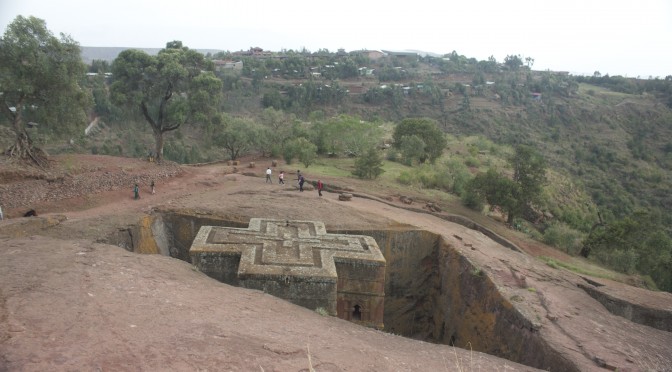I never thought spending two days visiting churches would be a highlight of my trip but it is; these aren’t ordinary houses of worship. 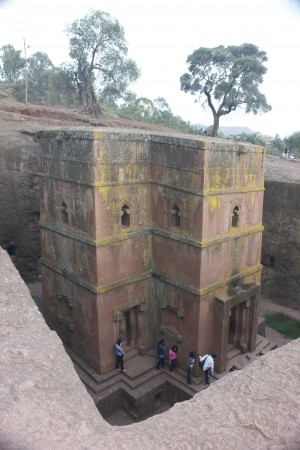 In Lalibela there are 11 rock-hewn churches and most are monolithic. Each church was carved from the top down from a single piece of rock. It is said that it took about 40,000 craftsmen using chisels and hammers 23 years to complete these structures. The top windows were the entry point used to hollow out the inside of the church. The roofs of these churches are at ground level so you must go down in order to enter. For security
In Lalibela there are 11 rock-hewn churches and most are monolithic. Each church was carved from the top down from a single piece of rock. It is said that it took about 40,000 craftsmen using chisels and hammers 23 years to complete these structures. The top windows were the entry point used to hollow out the inside of the church. The roofs of these churches are at ground level so you must go down in order to enter. For security 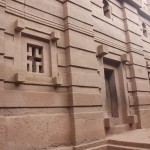 reasons they were connected by an elaborate underground tunnel system. Our guide said these churches, still used as places of worship for Ethiopia’s Orthodox Christians, were the vision of King Lalibela after he returned from a visit to Jerusalem.
reasons they were connected by an elaborate underground tunnel system. Our guide said these churches, still used as places of worship for Ethiopia’s Orthodox Christians, were the vision of King Lalibela after he returned from a visit to Jerusalem.
A few miles outside the village another King is credited with building his church, Yemrhane Kristios, during the 10th Century A.D. 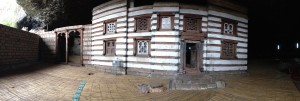 Unlike the churches in Lalibela this one was constructed with not just stone but also wood and mud. Aside from age, the unique feature is its location, built inside of a natural cave. The King is buried here and on October 19th, the date
Unlike the churches in Lalibela this one was constructed with not just stone but also wood and mud. Aside from age, the unique feature is its location, built inside of a natural cave. The King is buried here and on October 19th, the date  of his death, a tradition still exists which involves holding a rock on one’s shoulder and walking 3 times around the King’s casket. Followers believe doing this has healing powers.
of his death, a tradition still exists which involves holding a rock on one’s shoulder and walking 3 times around the King’s casket. Followers believe doing this has healing powers.
This is another place (Havana 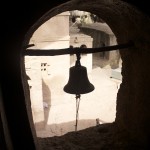 the other) where I wished my friend Eric B. (an architect) was here with me. Considering how in awe I was, I know he’d greatly appreciate these incredible structures.
the other) where I wished my friend Eric B. (an architect) was here with me. Considering how in awe I was, I know he’d greatly appreciate these incredible structures.
Life in Lalibela is simple. In this small village in the country, mountains make up the landscapes and donkeys and 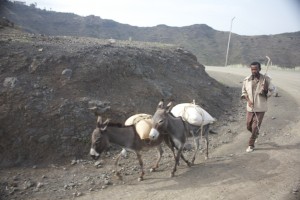 mules rule over any type of machinery. The culture seems to date back to the time when the amazing stone-hewn churches were built. The Saturday market brings people on foot from miles away. Here three main things are sold: agricultural products, livestock ($15 for a goat) and plastic shoes.
mules rule over any type of machinery. The culture seems to date back to the time when the amazing stone-hewn churches were built. The Saturday market brings people on foot from miles away. Here three main things are sold: agricultural products, livestock ($15 for a goat) and plastic shoes.
From the countryside to the city, Ethiopian coffee is everywhere and 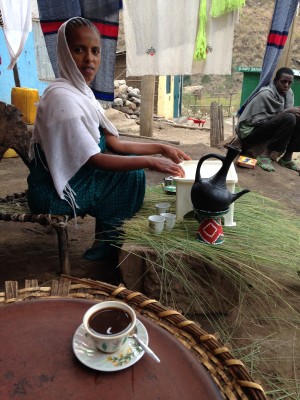 the best part is the way they brew it: over a small wood stove. After it has been brewed, the tiny cups of coffee are presented with a side of popcorn and a type of burning incense. This traditional ceremony is worth the maximum cost of a dollar for a good cup of coffee. Here in Lalibela the history is rich, people are nice and the prices are right. (Especially if you need a goat)
the best part is the way they brew it: over a small wood stove. After it has been brewed, the tiny cups of coffee are presented with a side of popcorn and a type of burning incense. This traditional ceremony is worth the maximum cost of a dollar for a good cup of coffee. Here in Lalibela the history is rich, people are nice and the prices are right. (Especially if you need a goat)

